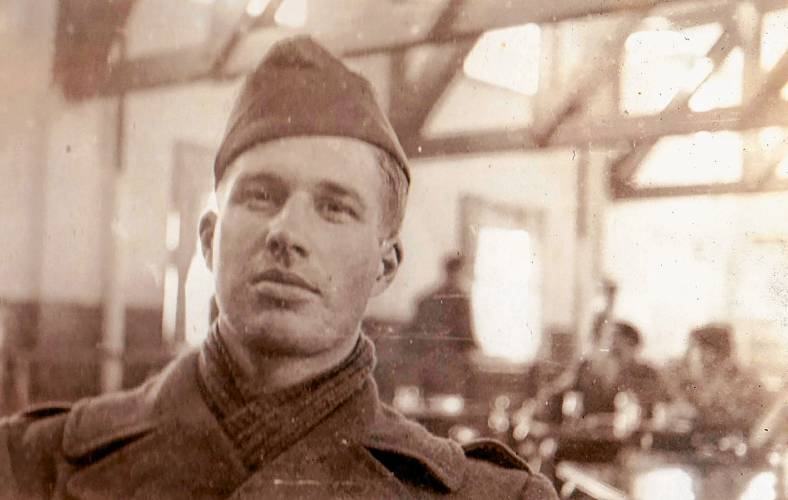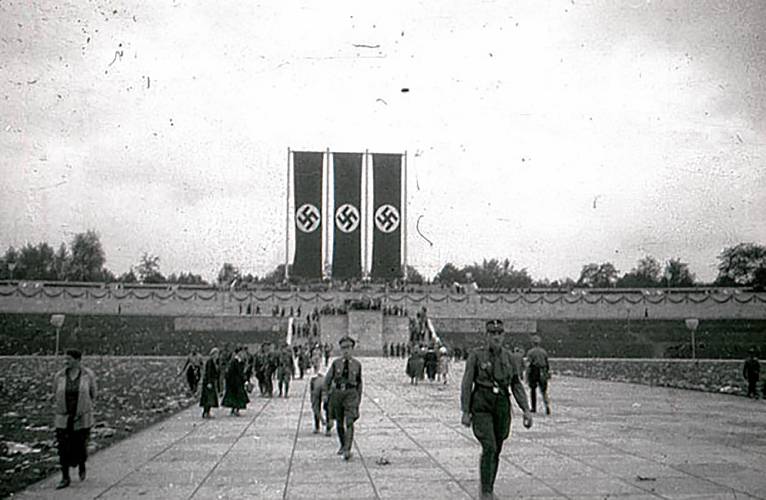Column: An American soldier’s view of the end of World War II
| Published: 11-14-2023 10:38 AM |
On March 29, 1945, American troops entered the town of Wetzlar, Germany, a small industrial center in the region of Hesse, about an hour north of Frankfurt. The U.S. Army Signal Corps filmed it. From a tank crossing a bridge in the center of town, the cameraman filmed the tentative approach of three well-dressed men carrying a white rag attached to a stick. Smoke billows from burning houses and shattered German military vehicles. American tanks fan out through the town, GIs with guns drawn. Now-freed slave laborers trudge by wrapped in rags and carrying bundles. A few smile weakly at the Army cameraman. One grabs a portrait of Hitler upended on a pile of rubble. He smashes it on a huge piece of masonry, over and over and over again.
The combat troops were followed several days later by troops from the U.S. Army’s Civilian Affairs Division. The army created CA when it saw frontline troops distracted by administering the land they retook and that the problems were too great for U.S.-based organizations. My mother’s younger brother, Norman R. Long, was one of the CA troops, whose mission was to restore local government and civil society and de-Nazify as well as sort out the thousands of displaced persons from across Europe who had washed up in Wetzlar on the tide of German aggression and greed.
I knew little about my Uncle Norman, who died before I was born and I had never heard of CA until Norman’s letters and wartime photo album turned up when cleaning out my childhood home. Today, it is hard to believe that there were a staggering 12 million American men under arms by 1945 — out of a possible 14 million. Each of these 12 million brought his own talents and experience and each made some contribution, whether bringing food, planning operations from a desk or healing a devastated land. With veterans dying off, their stories are being lost or submerged under easy narratives that flatter our nation’s image: Pearl Harbor, a few days on the beaches of Normandy or medal winners and flamboyant leaders such as generals Patton and MacArthur. These 12 million stories are no less important for being less dramatic.
In its wisdom, the U.S. Army assigned Uncle Norman to CA rather than combat, for which he was unsuited. He was college educated and spoke excellent French. And instead of spending his free hours drinking and chasing girls, Norman preferred learning German.
After landing in Normandy on June 28, 1944, Norman’s CA division moved slowly northeast. December 1944 found him in the Belgian village of Malmedy, just as the German offensive of the Battle of the Bulge arrived. Norman and the citizens of Malmedy were sheltering in the cellar of the mayor’s home when on Dec. 17, right above their heads, the Waffen-SS shot 80 American prisoners in cold blood.
Norman’s letters do not mention the Malmedy Massacre, one of Germany’s most notorious war crimes. In fact, the war is merely a distant background to Norman’s chronicle of complaints; his nerves, mood swings and difficulty relating to fellow GIs and officers. He writes home that cows and trees shape shift and speak to him on country walks. He asks his parents to send the sedative phenobarbital and when it arrives, he consumes it quickly. Doubts about life and God fill his letters. Will he ever meet a girl? What will he do after the war?
More immediate than the fight against Germany was Norman’s lifelong struggle with mental illness.
Wetzlar may have surrendered, but it was rough place.
Article continues after...
Yesterday's Most Read Articles
 Editorial: Dartmouth lets protesters know where they stand
Editorial: Dartmouth lets protesters know where they stand
 NH search crew finds remains of long-missing hiker in remote wilderness area
NH search crew finds remains of long-missing hiker in remote wilderness area
 City cites Claremont property owner over demolition of building
City cites Claremont property owner over demolition of building
 DHMC union organizers say they have enough signatures to force vote
DHMC union organizers say they have enough signatures to force vote
Nazi snipers still shot Americans. From his office window, Norman could see an amputated human leg lying on a garbage heap below. The town teemed with the lost and displaced. Norman bought ice cream for a prematurely tough 7-year-old Polish boy, who had walked to Wetzlar from whatever camp had devoured his family. The Nazis had brought thousands of men and women from across Europe to work as virtual slaves in Wetzlar’s factories. These languished in their barracks, too weak to travel or with nowhere to go. Some hid in nearby woods, sneaking out to steal Army property or kill Germans in revenge. Huffy Wetzlar burghers demanded that CA repair the craters in their gardens and broken windows caused by U.S. Army bombing.
There was rampant corruption. Norman’s officers inflated requisitions and then sold the excess on the black market. Despite rules about fraternizing, one CA secretary was a “Scottish girl” with a German accent; another’s husband was in the SS.
Nevertheless, Uncle Norman’s months in Wetzlar were an oasis of peace for him not just during the war, but for his whole life. Long walks in the springtime calmed and invigorated him. A sympathetic pastor let Norman play the organ in his village church. Norman gained new confidence. He learned how to fix his own truck. He discovered unknown competence, which emerged when he realized no one in Wetzlar judged him or cared that he was shy.
Norman worked in CA’s headquarters, which were in an imposing residence known as Villa Buderus. The villa’s size and central position had also recommended it as headquarters for its previous tenants, the National Socialist Workers Party. When Norman arrived, there were oil drums in the garden, where panicked Nazis had burned incriminating documents. Broken glass covered the villa’s floors and a portrait of Hitler dangled on a wall. In the wreckage, Norman found several boxes of glass slides, which he brought home as souvenirs. I found them with his letters.
Two of the boxes contained a Nazi propaganda slideshow called “Our Fighting Homeland.” Its images of what Germany was fighting against — Franklin D. Roosevelt and American Jews such as Justice Felix Frankfurter — and what it was fighting for — happy farmers bringing in the harvest — were too foul to keep. I donated them to the United States Holocaust Memorial Museum in Washington D.C.
There was a second group of 120 slides, also in a numbered slideshow. These were of the Nazi party’s 1934 Nuremberg rally, recognizable from Leni Riefenstahl’s notorious film “Triumph of the Will.” The ranks of marchers and flags and grandiose spaces are the image of tyranny, from North Korea to “The Lion King.” But this was a personal record of someone’s participation in the year’s biggest event, a sort of 1930s Instagram.
These images intrigued me. Who took them? Who were the men in them and what were their stories?
For one thing, they must have had a Wetzlar connection. For another, to hobnob with bigwigs and get a good seat at speeches by Josef Goebbels or Rudolf Hess, the photographer — no doubt a man — would have been a high-up party member of long standing.
In fact, a friend who has spent decades studying the Nazi hierarchy identified several men as the Wetzlar area’s Nazi hierarchy, including Gauleiter (regional leader) of Hesse Jakob Sprenger and his deputy and associates. Today only specialists know their names, but such men were as influential as the better-known Goebbels, Göring or Hess. From the Gauleiter down to the block leader, these were “Hitler’s viceroys,” who ran the Third Reich day-to-day. Germans called them the “little Hitlers.”
Researching these pictures and my uncle’s war experience led me to Wetzlar Erinnert (“Wetzlar Remembers”), a local organization that was founded in 2013 after a rash of neo-Nazi incidents. Its motto “multi-colored, not brown,” expresses its mission to keep the past from repeating itself by remembering the reality of Wetzlar under the Nazi “brown shirts.” W.E. saved from demolition the last remaining barracks for the Nazis’ forced laborers and made them a cultural center. It places historical markers and stolpersteine, the commemorative plaques inserted into the pavement with the names of Jews who had lived there. It collaborates with schools and local institutions on tours and educational programs.
When I contacted W.E.’s founder Ernst Richter and he heard about my Uncle Norman’s Wetzlar connection, he was enthusiastic. “Come visit!” he said. Since I had a trip to Europe planned already, I accepted. I added Wetzlar to my itinerary and arrived a few months later bringing copies of Norman’s photo album and the 1934 Nuremberg slides.
My Wetzlar visit began with a lavish breakfast at the home of Richter, who is a retired trade union official and his wife Irmi, a retired teacher. We were joined by another W.E. member — and translator — retired English professor Thomas Welling. After breakfast, Welling took me around Wetzlar. In the meantime, Richter worked on matching my photos to their locations.
Wetzlar’s historic center is a picturesque confection of cobbled streets and half-timber buildings. The central square looks just like Norman’s photos, minus the rubble and Nazi slogans. The synagogue is gone. Stolpersteine stud the pavement nearby and around downtown shops. The Villa Buderus is now a home for Alzheimers patients. The Gestapo headquarters and prison are gone, although a W.E. plaque marks the site. The forced laborers’ barracks are a few blocks away.
To compare, this area is not much bigger than downtown Hanover. Imagine if forced laborers lived in barracks near the football stadium and walked through town every day to work at a factory near CVS or the Green. Imagine 148 of your Jewish neighbors routed out of homes and their belongings auctioned while they disappeared on trains to the east.
Ernst matched most of Uncle Norman’s photos with their current locations, calling on Gisela Jäckel for those he did not recognize. Ninety-seven year old Gisela seems little less peppy than the 10-year old she was when the Americans arrived in 1945. Her Jewish mother was deported in 1942 and died in Auschwitz in 1944 along with her grandparents. Gisela herself was on a list of people scheduled for deportation, which Americans found in Villa Buderus.
Gisela immediately identified Norman’s billet, where a friend of hers had worked as a cleaner. Later she guided us to the exact spot where Norman had taken a picture during one of the walks that soothed his troubled mind.
Despite this history, and my photos of the local party officials, Wetzlar had not been a particularly Nazi town. In fact, the foundation of W.E.’s commitment to fighting the neo-Nazis reflected the town’s original resistance to right-wing extremism.
Wetzlar was able to emerge from the 1920s and 1930s economic and social turmoil that afflicted Germany relatively well. Its strong labor and social democratic tradition helped, when unemployment almost doubled between 1930 and 1932. Unlike Protestant areas where Nazism bred, Wetzlar had a mix of Protestants and Catholics, who actually shared use of Wetzlar’s cathedral. The town’s biggest newspaper disapproved of Nazi methods. And so did one of Wetzlar’s biggest employers, Ernst Leitz the owner of Leitz Optical, the pioneering manufacturer of microscopes and the Leica camera. Leitz kept Nazis cells from organizing in his and other factories. He founded and led a social-democratic coalition that fought both Communist and Nazi extremism.
Nevertheless, there was constant tension between the town’s more numerous Social Democrat and Communist groups and the National Socialists. Like a deadly rivalry between sports teams, agitators from all parties provoked each other into brawls during leafleting campaigns and social or political gatherings. Even with improvised arms such as table legs or homemade truncheons, the violence could be fatal. Nazi supporters also harassed Jews and invaded their businesses and social events.
For most of the 1920s, Wetzlar’s social democratic majority was more influential than the right-wing groups. That changed after 1924, when Hitler emerged as the right’s de facto leader and decided to pursue power through politics. Using the organizational skills he later applied to genocide, Heinrich Himmler ran a grassroots campaign. He urged party members to bring friends to Nazi events, such as Christmas parties and rallies. The latter attracted entertainment-starved rural voters with a mix of flag waving and marching with religious observances, and First World War commemorations, sports, music and theater. In between, Himmler inserted talks given by Nazi-trained speakers who tailored them for local interests and sophistication.
It worked. In Wetzlar, the Nazi party got 119 votes in the 1928 election; in 1930 it got 2,386. Most Nazi supporters were men between 18 and 30 years old. They were tradesmen, small-businessmen and farmers, most from rural areas near Wetzlar.
Such results gave Nazis national political power, which they capitalized on with the Reichstag fire in 1932 and legislation favoring a Nazi takeover. In January 1933, Adolf Hitler was appointed as Germany’s chancellor and the Nazis were in power.
Because the Nazis were still a minority, it was up to the Little Hitlers — the ones in my Nuremberg photos — to complete the Nazification of Wetzlar. They kicked out the town’s police chief and replaced him with their own man from Berlin. With the muscle of the party’s paramilitaries (the SA), newly empowered as police auxiliaries, they physically removed municipal workers from their jobs. They locked trade unionists out of factories and offices and stole their funds. So many were arrested that the Nazis had to organize a new system of “protective custody” and “concentration camps” to handle them.
Ernst Leitz remained an irritant. He helped Jewish employees to safety in Leitz affiliates abroad and resisted working for the German war machine until forced. His daughter was imprisoned by the Gestapo for helping Ukrainian women doing forced labor. Today, the Leitz family foundation is one of W.E.’s biggest sponsors.
After the war, the fates of Wetzlar’s Little Hitlers were mixed. Gauleiter Jakob Sprenger and his wife committed suicide on May 7, 1945. Wetzlar’s Kreisleiter (town leader) was captured by the British and sentenced for manslaughter. He served only six years of a life sentence and was occasionally seen in Wetzlar before he died in 1951.
Uncle Norman went home. Other veterans struggled with the war’s effect on them. But Norman’s struggle was the same as always. He tried divinity school, but then switched to getting a doctorate in French. Along with Norman’s war letters, there is one I don’t think I’ll ever read. It was found by his body in 1961 when concerned friends broke in after not hearing from him. It was Norman’s letter of surrender in a battle he decided he would never win.
A few months after I returned home, Ernst sent me an invitation to W.E.’s upcoming 10th anniversary celebration in September 2023. Once again, this fit in with my travel plans and I was able to attend.
The celebration was held in the cultural center now occupying the forced laborers’ barracks. There was music; a white-haired lady played guitar and sang “Blowin’ in the Wind” in German. And there were speeches; a local pastor who works with Jewish leaders, the head of the Leitz Foundation and the justice minister of the state of Hesse. The uniting theme was the necessity of remembering.
I could not always follow the German speeches. During Ernst’s speech, I sensed all eyes on me and realized he was talking about me. Ernst introduced me to the audience.
He thanked me for coming and explained about my uncle’s time in Wetzlar. For a moment, this one of the 12 million American stories about the Second World War and Norman’s contribution were not forgotten.
Madeleine Johnson is a freelance writer. She lives in Enfield.






 Editorial: Response to campus protests only adds fuel to the fire
Editorial: Response to campus protests only adds fuel to the fire Editorial: Chris Sununu’s moral vacuum
Editorial: Chris Sununu’s moral vacuum Editorial: Gambling tarnishes America’s sporting life
Editorial: Gambling tarnishes America’s sporting life
